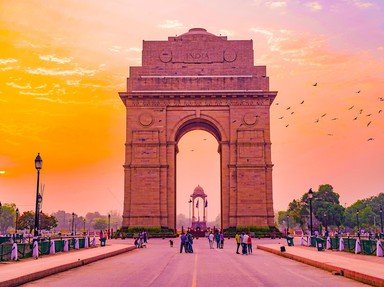Quiz Answer Key and Fun Facts
1. This representation of the Mughal "Alam", or royal standard, contains a lion and rising sun on a field of green. The Mughal Empire took much of its cultural influence from the Timurid Empire, which had been based in present-day Iran. As such, the lion was a common symbol for what cultural group that came to rule over India during the Mughal Empire?
2. Pictured in the center is Babur, the first Mughal emperor. Considering his family background, he had grand ambitions as he ruled from his small kingdom in Farghana (present-day Uzbekistan). On his father's side, he saw the rise and fall of the Timurid Empire. On his mother's side was the Mongolian Horde. Which two giants of history did Babur find in his familial line?
3. The son of Babur was overthrown by another ruler named Sher Shah Suri (also known as Sher Khan!) who took control of the Mughal lands. He instituted many reforms, including standardizing silver coins to 178 grains, which in effect became what currency of the Mughals?
4. The third Mughal emperor, Akbar, is often considered the greatest Mughal emperor. Not only did he institute grand social reforms, he was able to expand his empire's borders by three times their original size. This image shows soldiers under the command of Akbar during his reign. Along with the Ottoman and Safavid Empires, to what group did the Mughal Empire belong due to the nature of their military successes?
5. The Mughal Empire under Akbar (which was Sunni) grew increasingly intolerant of other religions, including Hinduism, Shia Islam, and Christianity.
6. The twentieth wife of Emperor Jahangir, she was known to hunt tigers and sit atop war elephants during battle. She often ruled the Mughal Empire while her alcoholic and opium-addicted husband was occupied. Who was she?
7. The fifth Mughal emperor, Shah Jahan, is perhaps most famous for the mausoleum he built for his wife. Yet the Taj Mahal wasn't the only famous landmark he built during his reign. He oversaw the construction of what Delhi landmark, which became the residence of the Mughal emperors?
8. Building on the conquests of his predecessors, the very shrewd sixth Mughal emperor, Aurangzeb, ruled the Mughal Empire at its largest extent, shown here. One of his last conquests was at Golcanda where he captured the Kollur Mine. The mine was the original home of the Koh-i-Noor, a relic that had been controlled by the Mughals since Babur had first captured it. What was the prize of the Kollur Mine?
9. In the eighteenth century, the Mughal Empire saw many ineffectual rulers, and due to the fact that the Mughals didn't practice primogeniture, sons of the previous emperors would often war with each other, weakening the empire as a whole. What group pictured here sought to become kingmaker, leveling their power at the throne and even committing regicide?
10. Here is Bahadur Shah II, the 17th and last Mughal emperor, who ruled only a small, shattered fragment of the mighty empire that had previously stood. Scared of French ambitions in India, what European power propped up the last few Mughal emperors before finally deposing Bahadur Shah II in 1857 and ending the Mughal Empire?
Source: Author
trident
This quiz was reviewed by FunTrivia editor
bloomsby before going online.
Any errors found in FunTrivia content are routinely corrected through our feedback system.

